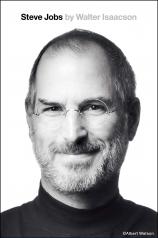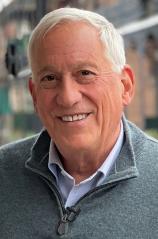Steve Jobs died on October 5, 2011. In our world of bite-sized attention spans, it probably seems to some that he has already been gone for decades. Rushed into publication only three weeks after Jobs’s death and several months ahead of its publication date, Walter Isaacson’s book is more a work of journalism than it is the kind of biography he’s written of subjects like Albert Einstein and Benjamin Franklin. With that caveat, it’s a thoroughly researched (more than 40 interviews with Jobs and over 100 with family, friends, business rivals and others) and comprehensive portrait of the life of an American business icon.
"[O]ne leaves Jobs’s story with an appreciation of the complex personality whose vision was responsible for delivering such a dazzling array of products and experiences."
Isaacson offers a chronological account of his subject’s life, from his adoption in 1955 until a few weeks before his death. There are times, especially after Jobs’s triumphant return to Apple in 1997, when the story feels like little more than a series of dramatic product launches (iPod to iPhone to iPad) loosely strung together. In its striving to be comprehensive, it skates across the surface of some events (such as the 2005 Stanford commencement speech) that would have benefitted from more thoughtful treatment. To those who followed Jobs’s career closely, Isaacson’s account of its highs (the launch of the MacIntosh in 1984, his purchase of Pixar in 1986, and his return to rescue Apple) and the lows (his ouster from the Apple board in 1985 and the failure of NeXT) will be familiar, but readers looking for a crisply-told overview of the man’s career will not be disappointed.
But below the surface Isaacson’s narrative, it's possible to discern the obsessions that dominated Jobs’s career. He saw himself as someone who “could stand at the intersection of humanities and sciences,” Isaacson writes. Not an engineer or a programmer, his passion, bordering on the maniacal, lay in delivering elegant, user-friendly, “perfect” products. Where companies like Microsoft freely licensed their software to third-parties, Jobs insisted that Apple products operate in a “closed garden.” If that meant designing a computer case that could not be opened without a special tool not available on the market, that was necessary to “control the user experience,” as he envisioned it, understanding that “true creativity and simplicity come from integrating the whole widget --- hardware and software, and for that matter content and covers and salesclerks.”
Isaacson’s book benefitted from a publicity campaign so pervasive that anyone exposed to it will have heard some of its more dramatic revelations. Among them: the story of Jobs’s discovery of his sister, novelist Mona Simpson, the encounter with his birth father (unknown to both men at the time), a former Silicon Valley restaurant owner, and his fathering of a daughter out of wedlock whose paternity he at first attempted to deny. Even with that, one leaves Jobs’s story with an appreciation of the complex personality whose vision was responsible for delivering such a dazzling array of products and experiences. From popularizing the graphical user interface, to revolutionizing the way we listen to music to the magical Toy Story movies, it’s almost impossible to overstate his cultural and technological significance. Anyone responsible for even one or two of his innovations would be hailed as a visionary.
Though Jobs’s cooperation with Isaacson obviously was extensive, the author makes no attempt to whitewash the episodes of bad behavior sprinkled liberally throughout the book. Whether it was parking his license plate-less Mercedes in a handicapped parking space or abusing waitresses whose service did not conform to his standards, Jobs’s personality charitably can be described as bordering on the antisocial. Yet it was that same unconventional perspective (Isaacson attributes much of Jobs’s worldview to his deep engagement with Zen Buddhism) and driving perfectionism he summoned to motivate those around him to achieve at an almost superhuman level.
When Jobs first was diagnosed with pancreatic cancer in 2003, his story takes a decidedly human turn. The same “reality distortion field” that enabled him seemingly to will into existence “astonishing products marked by beguiling user experiences” caused him to ignore medical advice for nine months before undergoing surgery, turning instead to exotic diets and holistic cures.
“He didn’t invent many things outright,” Isaacson observes, “but he was a master at putting together ideas, art, and technology in ways that invented the future.” If Steve Jobs had lived out the full span of years, no one knows whether he would have gone on to create more astonishing products or would have ended his life as a reclusive and bitter character, a Howard Hughes for the age of technology. We all know how the story ends, and yet, as Isaacson’s biography reaches its final pages, we somehow hope for a different conclusion to his subject’s remarkable life. Isaacson’s work will not be the final word on the life of Steve Jobs, but any future biographer will have to reckon with it.





